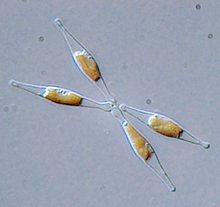Phaeodactylum tricornutum
| Phaeodactylum tricornutum | |
|---|---|

| |
| Scientific classification | |
| (unranked): | |
| Superphylum: | Heterokonta |
| Class: | Bacillariophyceae |
| Order: | Bacillariales |
| Suborder: | |
| Family: | |
| Genus: | Phaeodactylum
|
| Species: | P. tricornutum
|
| Binomial name | |
| Phaeodactylum tricornutum Bohlin, 1897
| |
Phaeodactylum tricornutum is a diatom. It is the only species in the genus Phaeodactylum. Unlike other diatoms, P. tricornutum can exist in different morphotypes (fusiform, triradiate, and oval) and changes in cell shape can be stimulated by environmental conditions.[1] This feature can be used to explore the molecular basis of cell shape control and morphogenesis. Unlike most diatoms, P. tricornutum can grow in the absence of silicon and can survive without making silicified frustules.[2] This provides opportunities for experimental exploration of silicon-based nanofabrication in diatoms.
Another peculiarity is that during asexual reproduction the
History

Phaeodactylum tricornutum was first described in the triradiate morphotype by Bohlin in 1897.[5] Recordings of the first cultures of P. tricornutum were published by Allen and Nelson in 1910, although it was misidentified as Nitzschia colsterium,W. Sm., forma miuntissima.[6] The isolate was later correctly revised as P. tricorntum by J.C. Lewin in 1958.[7] This strain among other later isolates are still maintained in culture collections around the world.[8]
Genome sequencing
Phaeodactylum tricornutum is one of a handful of diatoms whose genome has been sequenced. As of 2023, P. tricornutum is the only diatom for which a telomere-to-telomere genome assembly exists.[9] P. tricornutum is a diploid with 25 pairs of nuclear chromosomes.
P. tricornutum has emerged as a potential microalgal energy source. It grows rapidly and storage lipids constitute about 20-30% of its dry cell weight under standard culture conditions.[10][11] Nitrogen limitation can induce neutral lipid accumulation in P. tricornutum, indicating possible strategies for improving microalgal biodiesel production.
See also
References
- S2CID 85769550.
- S2CID 98646215.
- S2CID 29664801.
- PMID 19487243.
- ^ Bohlin, von K. (1897). Zur Morphologie und Biologie einzelliger Algen. p. 520.
- ^ Allen, E. J.; Nelson, E.W. (1910). On the Artificial Culture of Marine Plankton Organisms. pp. 421–74.
- PMID 13525659.
- ^ De Martino, Alessandra; Meichenin, Agnes; Shi, Juan; Pan, Kehou; Bowler, Chris. "Genetic and phenotypic characterization of Phaeodactylum tricornutum (Bacillariophyceae) accessions". Journal of Phycology (43): 992–1009.
- PMID 35811822.
- S2CID 18234512.
- PMID 23642220.
External links
- Yongmanitchai, W; Ward, O. P. (1991). "Growth of and Omega-3 Fatty Acid Production by Phaeodactylum tricornutum under Different Culture Conditions". Applied and Environmental Microbiology. 57 (2): 419–425. PMID 2014989.
- journals.tubitak.gov.tr The Growth of Continuous Cultures of the Phytoplankton Phaeodactylum Tricornutum (pdf)
- [1] picture of phaeodactylum tricornutum
